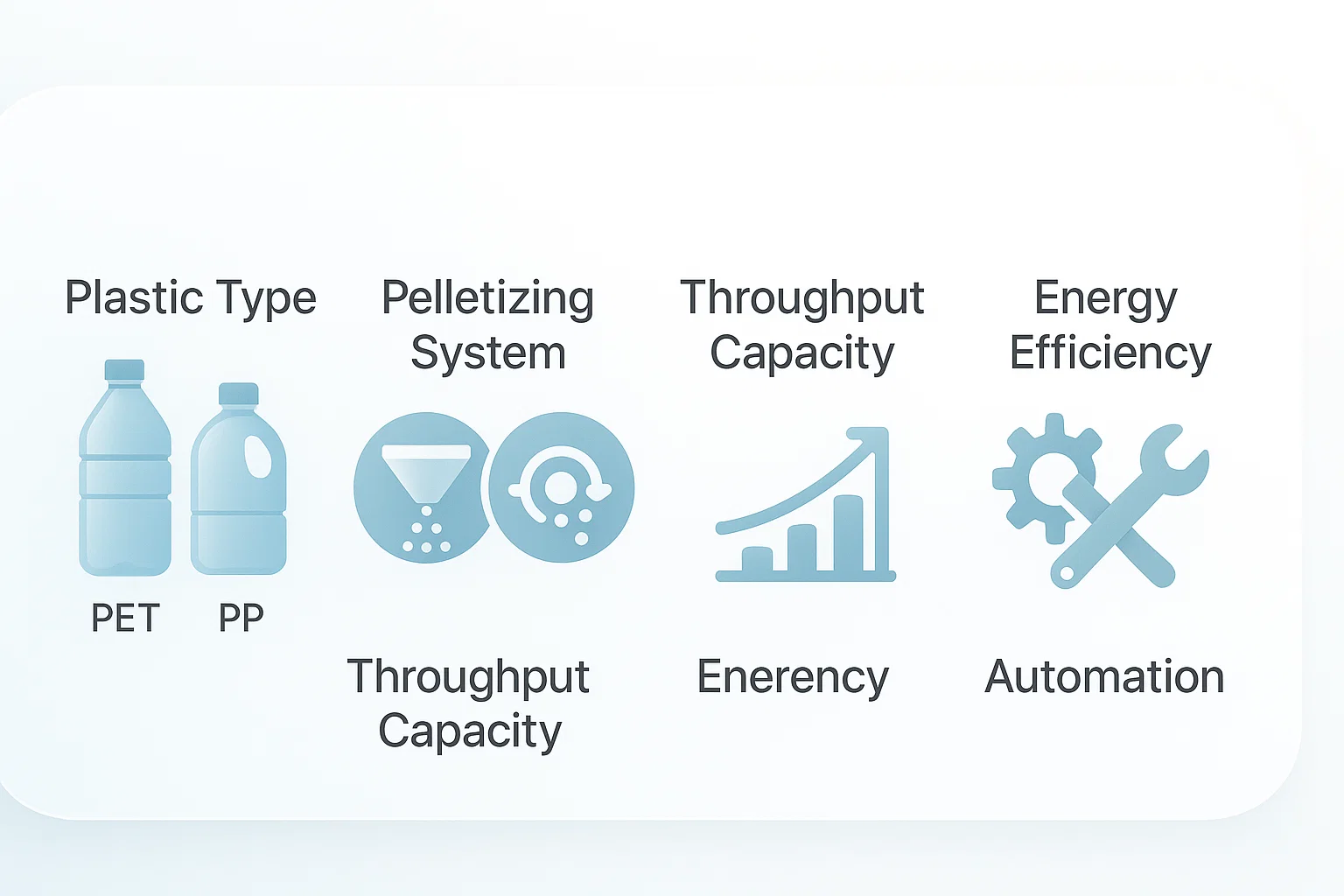Escolher o equipamento correto máquina de pelotização de plástico é crucial para garantir a eficiência e a qualidade alta no reciclagem de plástico. A escolha correta pode afetar dramaticamente sua produtividade, eficiência econômica e a qualidade dos seus grânulos finais. Este guia o guia através das considerações principais e dos tipos de máquinas para ajudar você a tomar uma decisão informada adaptada ao seu fluxo específico de resíduos plásticos.
1. Identificar o Tipo de Resíduo Plástico
Entenda Seu Material
Diferentes plásticos têm pontos de fusão, níveis de viscosidade e requisitos de manuseio distintos. Tipos comuns incluem:
- PET (Polietileneterefitalato)
- PE (Polietileno)
- PP (Polipropileno)
- PVC (Cloruro de Polivinila)
Cada tipo de plástico se comporta de maneira diferente durante o processamento. Por exemplo:
- PET e materiais de índice de fusão alto são mais adequados para pelotizadores de fio.
- PE e PP, especialmente filmes e materiais de reprocessamento, se destacam com pelotizadores de anel d'água.
[42] : Use sistemas de classificação automatizados para melhorar a precisão e reduzir custos de mão de obra. As soluções da Energycle se integram perfeitamente com equipamentos de classificação para um fluxo de trabalho simplificado.: Certifique-se de que sua máquina é compatível com o seu resíduo plástico primário para evitar ineficiências ou defeitos no produto.
2. Escolha o Sistema de Pelotização Apropriado
Existem três sistemas principais de pelotização, cada um com benefícios distinguidos dependendo do seu material e aplicação:
Sistema de Pelotização de Fio
- Como funciona: O plástico derretido é extrudido em fios, resfriado em um banho de água e cortado em grânulos.
- Melhor para: PET, ABS e outros materiais de alto índice de fusão.
- Vantagens: Produz grânulos uniformes; ideal para plásticos de engenharia.
Sistema de Pelotização com Anel de Água (Face de Dies Quente)
- Como funciona: O plástico é cortado diretamente na face do die com facas rotativas e resfriado em um anel de água.
- Melhor para: PE, PP, filme, palha, sacos tecidos, e reprocessamento.
- Vantagens: Fácil de operar, mínima quebra de fios, manutenção baixa.
Sistema de Pelotização Subaquática (Para uso especializado)
- Usualmente utilizado para operações de alta capacidade e compostos projetados.
- Mais complexo e caro, mas fornece grânulos de alta qualidade para indústrias específicas.
[57] 3. Avaliar a Capacidade de Produção da Máquina
[58] Ajuste a Produção às Suas Necessidades
[59] Capacidade de produção (geralmente medida em [60] kg/hora[61] ) deve estar alinhada com seus objetivos de produção:
- [62] Operações de pequena escala[63] : Procure por máquinas compactas com capacidade menor para economizar energia e espaço.
- [64] Operações de grande escala[65] : Escolha máquinas com maior capacidade de saída para garantir processamento consistente e eficiente.
[42] : Use sistemas de classificação automatizados para melhorar a precisão e reduzir custos de mão de obra. As soluções da Energycle se integram perfeitamente com equipamentos de classificação para um fluxo de trabalho simplificado.[67] : Sobrestimar a capacidade pode levar ao subuso; subestimá-la pode levar a gargalos.
[68] 4. Priorize a Eficiência Energética
[69] Reduza os Custos Operacionais
[70] Máquinas de pelotização energéticas ajudam a reduzir despesas com eletricidade a longo prazo. Procure por:
- [71] Elementos de aquecimento otimizados [72] Motores servo
- Servo motors ou inversores de energia econômica
- barris de extrusão isolados
Máquinas eficientes oferecem não apenas economia de custos, mas também um impacto mais sustentável para o seu negócio.
5. Avaliar Manutenção e Durabilidade
Escolha Máquinas Construídas para Durar
Máquinas confiáveis com tempo de inatividade mínimo são essenciais para a lucratividade:
- Sistemas de limpeza automática simplificam a manutenção.
- O uso de aço inoxidável resistente à corrosão garante a longevidade.
- Peças facilmente acessíveis reduzem o tempo gasto em reparos.
[42] : Use sistemas de classificação automatizados para melhorar a precisão e reduzir custos de mão de obra. As soluções da Energycle se integram perfeitamente com equipamentos de classificação para um fluxo de trabalho simplificado.: Sempre considere a disponibilidade de peças de reposição e suporte do fabricante.
6. Considerar Recursos de Automação e Controle
Melhorar Precisão e Eficiência
Modern máquinas de pelotização de plástico geralmente incluem automação inteligente para:
- Monitoramento em tempo real
- Controle de temperatura e pressão
- Ajuste de capacidade de produção
A automação melhora a precisão, reduz custos de mão-de-obra e garante a consistência da qualidade das pelotas.
7. Considerações Especiais para a Reciclagem de Filmagem de Plástico
Se o seu material primário for filme plástico (por exemplo, filme de PE, sacos de tecido de PP, filme BOPP), considere linhas integradas de reciclagem e pelotização que combinam:
- Trituração
- Extrusão
- Pelotização
Esses sistemas são projetados para:
- Eficiência de espaço
- Instalação fácil
- Desempenho de economia de energia
- Componentes de espiral e barril duráveis
Tais configurações melhoram o fluxo operacional e são ideais para aplicações de reciclagem em ciclo fechado.
Resumo: Factores Chave na Escolha de uma Máquina de Pelotização de Plástico
| Fator | Recomendação |
|---|---|
| Tipo de Plástico | Ajuste a máquina para PET, PE, PP, PVC, etc. |
| Sistema de Pelotização | Use fita para PET/alto derretimento; anel d'água para PE/PP, filme |
| Capacidade de Produção | Escale a máquina para a sua capacidade de produção |
| Eficiência Energética | Priorize sistemas de baixa energia e alta eficiência |
| Manutenção | Escolha equipamentos fáceis de limpar e resistentes à corrosão |
| Automatização | Procure máquinas com controle em tempo real e operação inteligente |
| Reciclagem de Filmes | Utilize linhas integradas para filmes, palha e sacos tecidos |
Penseiras Finais
Investir no certo máquina de pelotização de plástico significa entender tanto suas necessidades de material quanto suas necessidades operacionais. Seja você processando plásticos rígidos ou filmes flexíveis, a compatibilidade da máquina com a tarefa garante maior eficiência, maior qualidade de grânulos e economias a longo prazo.
Precisa de ajuda na seleção da máquina certa? Entre em contato com nossa equipe especializada — estamos aqui para ajudá-lo a encontrar a solução mais econômica e confiável para sua operação de reciclagem de plástico.
Me avise se você gostaria que isso fosse formatado para upload na web (HTML ou CMS pronto), ou se deseja conteúdo adicional como links internos, perguntas frequentes (FAQs) ou chamadas para ação (CTAs).

